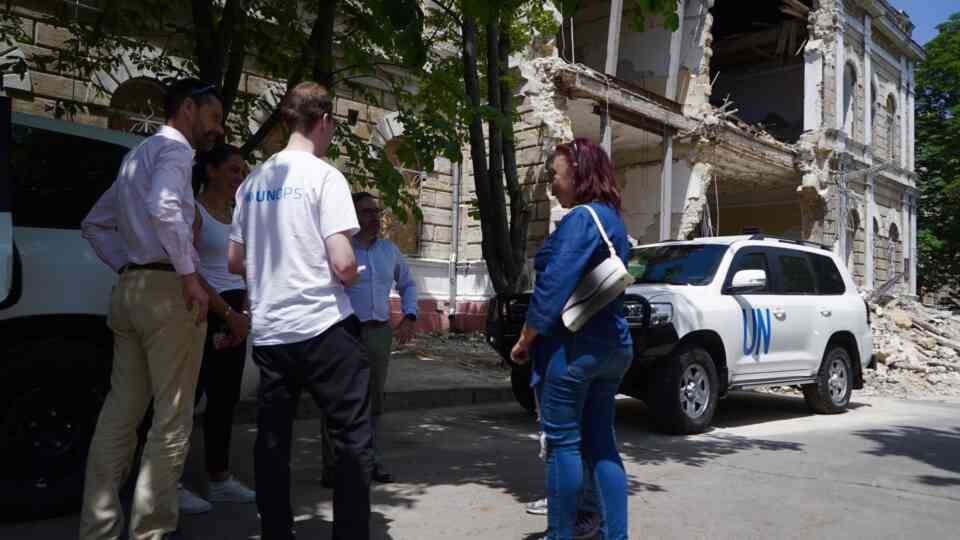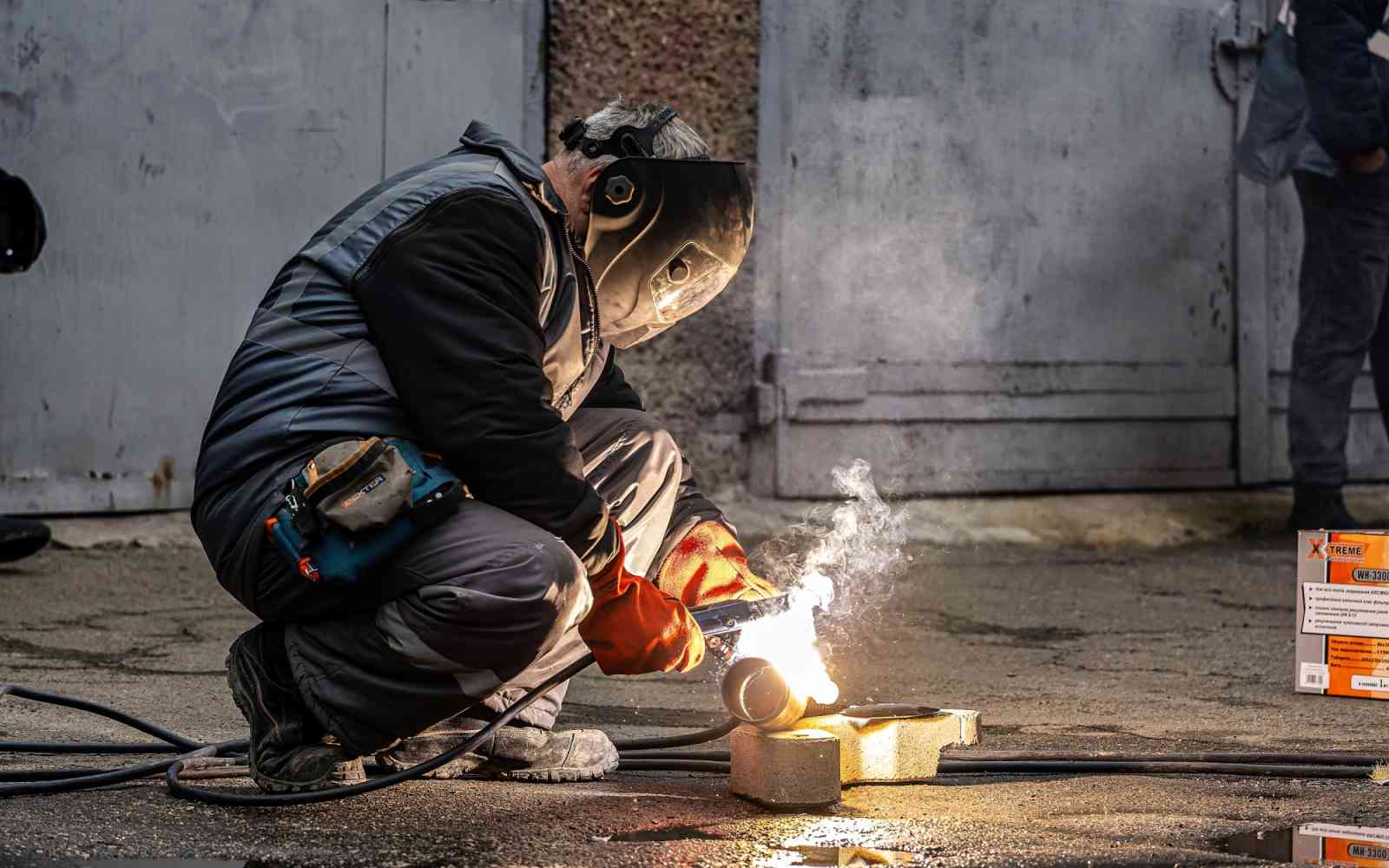The United Nations Office for Project Services (UNOPS)

The path to recovery: rebuilding hope in Kharkiv
In Kharkiv’s Saltivka District, with funding from the government of Japan, UNOPS is working to revitalize a residential micro-district.
Situated in the northeast of Ukraine, less than 40 kilometres from the Ukraine-Russia border, lies the city of Kharkiv. Once home to approximately 1.5 million people, the city found itself under heavy artillery fire and missile attacks from the onset of Russia's invasion of Ukraine in February 2022. Russian forces advanced towards the city from the north, leading to local skirmishes in the city's northern outskirts.
From February to September 2022, Kharkiv was subjected to regular attacks. The city bears the scars of the war, with no area left untouched. The sight of missing windows and walls pockmarked with holes is common as one navigates through the city streets. Among the most heavily impacted is the residential district of Saltivka, where weeks of targeted artillery and multiple rocket launcher fire have left some buildings completely destroyed.
In response to this devastation, UNOPS, with funding from the government of Japan, is working to restore two individual multi-apartment buildings and two micro-districts in Kharkiv. We travelled to one of the micro-districts, located in the Saltivka area, to witness the damage and speak to the residents.
Saltivka is primarily composed of late-Soviet era apartment blocks made of prefabricated concrete panels. Today, it stands as a stark reminder of the war that has ravaged the city. Through the restoration efforts, UNOPS is helping breathe new life into these buildings and, by extension, the city of Kharkiv. The micro-district selected for restoration in cooperation with the local authorities is a cluster of 17 buildings, all situated in close proximity to each other. These structures, originally built between 1989 and 1991, have been home to many of the residents for as long as they have stood.
The micro-district also houses two kindergartens, a school and a health clinic, making it a vibrant community hub. With over 2,800 apartments, this area was home to more than 7,000 people before the war started.
Through the restoration efforts, UNOPS and the government of Japan are not just rebuilding structures, but are also helping to mend a community torn apart by war. The goal is to restore a sense of home and provide opportunities for the thousands of residents who have lived through unimaginable circumstances.
Similar to the broader Saltivka area, the micro-district has been subjected to multiple shellings. The damage inflicted has been extensive, resulting from direct hits, flying debris and the powerful blast waves that followed the explosions. Not one of the 17 buildings within the micro-district has been spared.
We spoke to Valerii Kurtsev, who works for Zhytlo-komun-servis, the municipal company that manages most of the 17 buildings. He described the overwhelming scale of the damage: between 80 and 90 per cent of window panes have been shattered from attacks. In response, municipal workers and volunteers stepped in to board up the openings. This measure protected the interiors from the elements and improved insulation. Some residents have taken matters into their own hands, investing in new windows to replace those lost.
“We keep stressing that recovery is a multi-faceted process,” explains Jan Philip Klever, UNOPS Ukraine Head of Programme.
“Restoring residential buildings in itself is not enough: communities also need robust infrastructure, healthcare, education and economic opportunities to be able to revive after the horrors of war that they endured. This project is hopefully one of many showcasing this approach. With support from our key partners, Japan being one of them, we can instill cross-sectoral thinking as a fundamental principle for Ukraine’s recovery.”
In many instances, the damage has led to individual panels or groups of panels breaking and falling from the buildings. Some apartments are now missing balconies, floors, or even entire walls. In one case, an entire section of a building, spanning from the third to the sixth floor, is completely missing, leaving a gaping hole amidst the apartments below and above that remain intact.
In some cases, the impact of the shelling ignited fires that caused further devastation to the apartments. These units have suffered the most severe damage, to the extent that repairs are virtually impossible.
Despite the devastation, the residents are looking for ways to bring life back to their neighbourhood. Valerii shared that Zhytlo-komun-servis is focusing significant efforts on restoring utility systems within the buildings, including water, electricity and heating, ahead of the coming winter. He emphasized the importance of restoring heating to prevent the growth of mold in the apartments, which comes with health and cost concerns.
Valerii spoke with admiration of the resilience demonstrated by the local residents. "Many have gone into a state where nothing seems to unsettle them anymore,” he says.
"Despite the danger, I am not thinking about leaving. While my wife and child have relocated to Kropyvnytskyi for safety, I remain here, doing my job for the people. I get to talk to them daily, and I can see how much they need understanding and support,” he adds.
Liudmyla Khodova, 63, fled Kharkiv in the initial days of the war and sought refuge in a monastery in the west of the country for a few months. Upon her return in April 2022, she was met with her home in ruins. Electrical wiring was torn apart, walls had caved in and windows were smashed.
Her neighbours recounted a terrifying incident when their building was hit by rockets. Mine experts from the State Emergency Service had to remove unexploded ordnances and fragments from several apartments, including Liudmyla's. She has kept some of the fragments, stored in a box, as a stark reminder of the war that disrupted her life.
The couple Valentyna and Vasyl Maslii, 69 and 70, remained in Kharkiv throughout the war. During the attacks, they, along with other residents of their building, sought refuge in the basement. It was only in the autumn of 2022 when the Russian forces were pushed away from Kharkiv, that they were able to return to their apartment full time.
Their apartment bears the scars of the war - windows are boarded up, walls are broken and there is a sizable hole in the floor. Still, they remain steadfast in their commitment to staying here.
“We have lived here for 35 years,” says Valentyna. “This is our home, and we won’t be leaving it any time soon.”
“It’s great that help is coming our way, and we are incredibly grateful,” stresses Vasyl. “I just hope all the essentials are done by the winter, and no more damage is inflicted in the meantime.”
Together with international experts and partners, UNOPS is currently conducting a detailed assessment of the condition of all the buildings in the micro-district. This is a meticulous and time-consuming process.
While some buildings may appear structurally intact at first glance, a more thorough inspection reveals a different story. Hidden beneath the surface are cracks, holes and deformations, along with damage to essential utilities such as water and heating pipes, wiring and ventilation systems.
Residents have voiced concerns about leaky roofs and draughty windows, issues that exacerbate the harshness of the region's winters. Many are worried that their apartments, in their current state, will be unliveable when the cold season arrives. These concerns underscore the urgency of the restoration work being undertaken in the micro-district.
A team of structural engineering and disaster management experts are working closely with building managers, which include Valerii’s company and homeowners associations, to arrange access to restricted areas such as roofs, basements and technical premises. The team is also making concerted efforts to establish contact with individual residents to gain access to their apartment units and assess the damage within.
However, with many units left vacant, locating their residents is not always a straightforward task. Despite the challenges, the team is committed to ensuring a thorough and accurate assessment of the damage, a crucial step in the restoration process.
Once the assessment is complete, UNOPS will oversee the construction works. It is expected that urgent repairs will be undertaken before the arrival of this year’s winter, with more extensive works to be carried out through spring 2024.
Overall, in all of its locations, the project seeks to comprehensively address the needs of the local communities. This includes restoring residential buildings and essential infrastructure, and providing support to local businesses. In the spirit of cooperation, a separate UNOPS-implemented project, funded by the European Union, is working to repair a school in Kharkiv.
About this project
The project, with funding from the government of Japan and implemented by UNOPS, initially covered urgent energy-related needs by providing generators to district heating, water supply, housing maintenance, medical and educational facilities.
Now, it is focused on the revitalization of communities in Kharkiv, including the Saltivka District, an area severely impacted by the conflict that began in February 2022. The initiative will restore residential buildings, and essential infrastructure, and provide support for local businesses, aiming to rebuild not just physical structures but also the community that has been torn apart by the war.
The restoration efforts include detailed damage assessment with an overall goal to complete the repairs by spring 2024. This involves a multi-faceted approach to recovery, emphasizing the re-establishment of robust infrastructure, healthcare, education and economic opportunities to foster a resilient and thriving community.




































